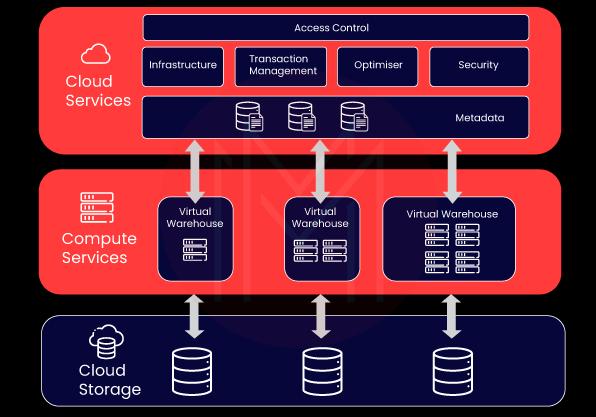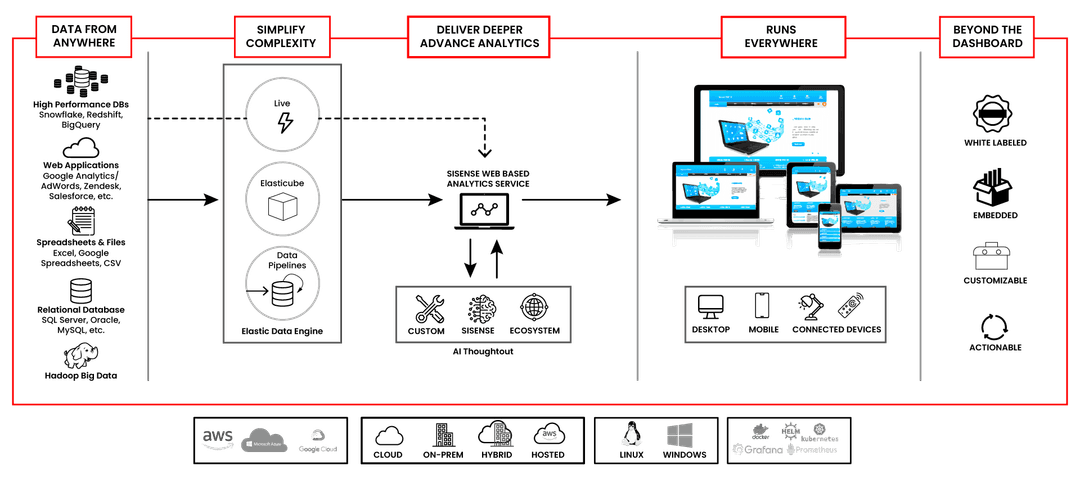- Snowflake Interview Questions and Answers
- Snowflake Tutorial
- Snowflake Architecture
- Star schema and Snowflake schema in QlikView
- Snowflake vs Redshift - Which is the Best Data Warehousing Tool
- Snowflake vs BigQuery
- Snowflake Time Travel - A Detailed Guide
- What is a Snowflake Table & Types of Tables
- Snowflake vs Databricks
- Snowflake vs Azure
- Snowflake Vs Hadoop: What's the Difference?
- How to Insert Data in Snowflake
- Snowflake Connectors
- Snowflake Documentation - A Complete Guide
- How to Update Data in Snowflake?
- How to Delete Data in Snowflake
- How to Add a Default Value to a Column in Snowflake
- How to Add a Column in Snowflake
- How to Add a NOT NULL Constraint in Snowflake
- How to Alter a Sequence in Snowflake
- How to Create a Table in Snowflake
- How to Create a View in Snowflake
- How to create an Index in Snowflake
- How to Drop a Column in Snowflake
- How to Drop a Table in Snowflake
- How to Drop a View in Snowflake?
- How to Drop the Index in Snowflake
- How to Duplicate a Table in Snowflake
- How to Remove a NOT NULL Constraint in Snowflake
- How to Remove a Default Value to a Column in Snowflake
- How to Rename a Table in Snowflake
- How to Rename a Column in Snowflake
- How to write a Common Table Expression(CTE) in Snowflake
- How to Write a Case Statement in Snowflake
- How to Use Coalesce in Snowflake
- How to Query a JSON Object in Snowflake
- How to Truncate a Table in Snowflake
- How to Group by Time in Snowflake
- How to Import a CSV in Snowflake
- How to Query Date and Time in Snowflake
- How to Convert UTC to Local Time Zone in Snowflake
- How to Avoid Gaps in Data in Snowflake
- How to Have Multiple Counts in Snowflake
- How do we Calculate the Running Total or Cumulative Sum in Snowflake
- How to Round Timestamps in Snowflake
- How to Calculate Percentiles in Snowflake
- How to Compare Two Values When One Value is Null in Snowflake
- How to do Type Casting in Snowflake
- How to Get First Row Per Group in Snowflake
- Snowflake Cloning - Zero Copy Clone
- Snowflake Competitors and Comparisons
- Snowflake Integrations
- Snowflake Key Features
- Snowflake Tables and View Management
- Snowflake Advanced Querying & Analytics
- Snowflake SQL Functions & Conditionals
- Snowflake DML and Constraint Operations
Previously, setting up a data warehouse used to involve purchasing a costly, custom-built hardware appliance and installing it in your data center. Snowflake, on the other hand, is a data warehouse that is available as software-as-a-service (SaaS).
It’s built from the ground up to be a cloud and provides the flexibility and efficiency that a typical data warehouse just cannot offer.
This article will explain what Snowflake Data Warehouse is, how it works, and the major features of this revolutionary technology.
| Table of Content - Snowflake Data Warehouse |
|
➤ What is a Snowflake Data Warehouse ➤ How does Snowflake Data warehouse work? ➤ Snowflake’s Differentiating Features from Other Cloud Data Warehouses ➤ Snowflake's Most Important Use Cases |
What is a Snowflake Data Warehouse?
Snowflake is a cloud-based data warehouse that runs on Amazon Web Services or Microsoft Azure. It's great for enterprises that don't want to devote resources to the setup, maintenance, and support of in-house servers because there's no hardware or software to choose, install, configure, or manage.
Snowflake's design and data exchange capabilities, however, set it distinct. Customers can utilize and pay for storage and computing separately thanks to the Snowflake architecture, which provides storage and computation to independently scale. Furthermore, the sharing feature enables enterprises to instantly communicate controlled and secure data in real-time. You can learn more in Mindmajix’s Snowflake Online Training.
| If you want to enrich your career and become a professional in Snowflake, then enroll in "Snowflake Online Training" - This course will help you to achieve excellence in this domain. |
How does Snowflake Data Warehouse work?
Snowflake has a lot of cool capabilities, but one of the most impressive is the ability to create an endless quantity of virtual warehouses (each efficiently an independent MPP cluster). As seen in the picture below, users can execute an endless number of independent workloads against the same data without fear of contention.

Furthermore, each warehouse can be scaled from a single node extra-small cluster to a gigantic 128-node monster in milliseconds. Users won't have to put up with subpar performance because the machine's size may be modified during the day to match the workload. Lastly, in addition to scaling up for greater data volumes, it's also possible to scale out to handle large numbers of users automatically.
Snowflake Architecture
The levels in the Snowflake service are depicted in the diagram below:
1. Cloud Service Layer:
This covers infrastructure, transaction management, SQL performance optimization, security, and metadata, as well as providing database connectivity. The cloud services layer organizes the entire system and uses ANSI SQL.
2. Compute Services Layer:
Hosts an almost infinite number of virtual warehouses, each of which is made up of a cluster of database servers that execute SQL operations. Despite the fact that the virtual warehouse is made up of CPUs, memory, and SSD storage, this is only a transitory storage layer.
3. Cloud Storage Layer:
Provides an inexhaustible source of long-term data storage. All data is saved in the cloud and is automatically copied to three different data centers, providing a disaster recovery layer built-in.
Although virtual warehouses can be started and stopped manually, the layers of the architecture work transparently to service end-user SQL queries. You can learn more about Snowflake Architecture.

| Read these latest Snowflake Interview Questions that help you grab the high-paying job |
Snowflake’s Differentiating Features from Other Cloud Data Warehouses
- Snowflake is a cloud-based data warehouse that uses a subscription-based model with storage and computing running independently. Snowflake's technology uses elastic storage to automatically use hot/cold storage strategies to reduce costs, and scalable computing eliminates the usual concurrency limits that other warehouse options impose.
- Snowflake's data warehouse is cloud-agonistic, allowing customers to use several clouds. Snowflake is accessible on Microsoft Azure, Google Cloud, and Amazon Web Services at the moment.
- Snowflake saves both structured and semi-structured data and converts it to a SQL-compatible format.
- Users can query data quickly without altering the underlying data set and receive data that is closer to real-time.
- Snowflake's customizable cloud server solution decentralizes data, allowing each stakeholder or group within an organization to access specific data sets without the need for lengthy data transfers.
- The company's services are available on-demand, allowing users to choose the amount of computation and storage they require before paying for it on a per-use or monthly fixed-rate basis. Because of Snowflake's flexible payment structure, compute and storage may be turned on and off as needed for certain instances and projects without incurring long-term costs.
Related Article: Star Schema and Snowflake Schema in QlikView
Snowflake's Most Important Use Cases
Snowflake's scalable architecture and simple querying make it an excellent tool for businesses that are just getting started with the data-driven paradigm.
The platform's usability and adaptability make it a powerful tool for businesses looking to test new systems, build their own analytical models, or try out multiple techniques to meet their data analysis and business intelligence needs.
- Ad hoc analysis: Snowflake allows users to design their own queries. Snowflake's virtual warehousing enables users to create their own databases using both live and cached data, resulting in faster queries and more near-real-time BI insights.
- Embedded Analytics. Snowflake provides embedded analytics applications with the elasticity, flexibility, and scalability they require.
| Related Article: Difference between Snowflake vs Databricks |
What type of database is Snowflake?
Snowflake was designed from the ground up to be a full-featured SQL database. It's a columnar-stored relational database that works well with Excel, Sau, and a variety of other tools that end-users are familiar with. Snowflake has its own query tool and supports multi-statement transactions, role-based security, windowing functions, full DML, and all other SQL database features.
Snowflake data warehouse pros and cons
The benefits of Snowflake cloud-based data warehousing have been thoroughly explored.
- Performance and speed: Because of the cloud's elasticity, you can scale up your virtual warehouse to take advantage of more compute resources if you need to load data faster or perform a large number of queries. After that, you can scale the virtual warehouse and only pay for the time you used it.
- Accessibility and concurrency: When too many queries compete for resources in a typical data warehouse with a high number of users or use cases, you may suffer concurrency difficulties (such as delays or failures).flake's innovative multicluster architecture solves concurrency issues: Virtual warehouse queries never affect queries from other virtual warehouses, and individually virtual warehouses can scale up or down as needed. Without having to wait for other loading and processing processes to finish, data analysts and data scientists may acquire what they need when they need it.
- Software Upgrades: Upgrades to the software are no longer required. Snowflake is delivered as a software service, thus changes to the operating system and database are applied silently and transparently.
- Tuning and Maintenance: This is no longer an issue because Snowflake does not support indexes, and there is no need to adjust the database aside from a few well-documented best practices. There are few requirements for DBA resources because the system is designed to be simple.
- Security and availability: Snowflake is designed to run constantly and withstand network and component failures with the least impact on clients, and it is dispersed across availability zones of the platform on which it runs – either AWS or Azure. It is SOC 2 Type II certified, and it offers additional security features such as PHI data support for HIPAA clients and encryption across all network connections.
- Data exchange is seamless: Snowflake's architecture allows users to share data with one another. It also enables businesses to share data with anyone, whether or not they are a Snowflake customer, via reader accounts that can be created straight from the user interface. The provider can use this feature to create and maintain a Snowflake account for a customer.
There isn't much to write about in terms of drawbacks.
Conclusion
These days, the Snowflake data warehouse is gaining a lot of traction, and learning it proves to be more productive than traditional-based solutions. By incorporating Snowflake into their operations, companies enhance their performance.
 On-Job Support Service
On-Job Support Service
Online Work Support for your on-job roles.

Our work-support plans provide precise options as per your project tasks. Whether you are a newbie or an experienced professional seeking assistance in completing project tasks, we are here with the following plans to meet your custom needs:
- Pay Per Hour
- Pay Per Week
- Monthly
| Name | Dates | |
|---|---|---|
| Snowflake Online Training and Certification Course | Jan 13 to Jan 28 | View Details |
| Snowflake Online Training and Certification Course | Jan 17 to Feb 01 | View Details |
| Snowflake Online Training and Certification Course | Jan 20 to Feb 04 | View Details |
| Snowflake Online Training and Certification Course | Jan 24 to Feb 08 | View Details |

Satish is a Data Management and Governance Practitioner with over 16 years of IT experience supporting enterprises to develop and optimize solutions that result in high value. He has an experience spanning across Data Warehouse ETL leveraging Informatica PowerCenter & Custom Tools, Databases like Teradata, Oracle, MS-SQL & Greenplum, Integrations design with MuleSoft, and Implemetation of Data Catalog, Governance and lineage applications such as Alation, Collibra & Manta at an Enterprise level. Satish was associated with GE, Dell & E2Open with successful implementation of Supply Chain integration solutions for several AMER & APJ region organisations. Currently, he is a Tech Lead at Dell within Information Governance space who plays a key role in setting up governance practice from grass-roots that traverse maturity through stewardship with a Business rules framework for data quality, metadata, and governance access capabilities. Satish is also actively involved in mentoring students at various levels from high school and Engineering as part of CSR by associating with various organizations such as FFE, to impart knowledge that would help gain insights on skills essential to be successful in their professional journey.












